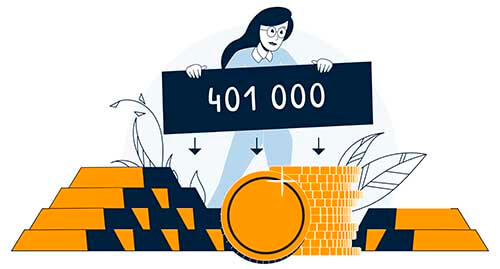
Gold vs. ETF Investments
Gold, as an investment tool, is a complete package. It may not wholly outshine other investing assets at a particular thing but does cover pretty much all bases. For instance, it appreciates over time, offers shelter during an economic uncertainty or when currencies are unstable, etc., thanks to its inverse relationship with the stock market. Physical gold ownership also affords a sense of satisfaction or accomplishment.
But then there are issues with buying or owning physical gold, where digital gold – or, to be specific, gold ETF – enters the room. If buying gold and taking physical custody of the metal sounds like a hassle, gold exchange-traded funds are solid alternatives. But then the gold fund has a few shortcomings or aspects that people who like investing in gold would find off-putting.

So, what are those good and bad things about investing in gold ETFs or buying physical gold? If you’re on the fence or divided between the two, you may want to read this. In this detailed comparison, we’ll go through:
- What is physical gold and gold ETF
- Pros and cons of buying the precious metal
- Positives and negatives of investing in gold ETFs and much more
- Best gold ETFs and more
Since physical gold is familiar territory, we’ll not focus a lot on it. Instead, we’ll emphasize a tad more on gold ETFs so that traditional investors know more about the alternative.
Table of Contents
A Brief Intro to Gold
Gold is a household metal that doesn’t need any introduction, as mentioned above. When regular people think about gold, the first thing that comes to mind is jewelry. But if viewed from an investment angle, gold bullion in coins and bars is more the focus. Unlike jewelry, which you can only purchase at a jeweler, you can buy gold bullion at banks, dealers, jewelers, etc.
Read more: Is Gold Jewelry a Good Investment
What is a Gold ETF? How Does It Work?

A gold ETF (exchange-traded fund) is a type of gold fund. Gold mutual funds invest in gold ETFs. Gold ETFs are commodity ETFs invested in pure gold only. Other underlying commodities an ETF could be invested in include agricultural goods (rice, wheat, coffee, tea, etc.), natural resources, and other precious metals—such as silver, platinum, and the likes.
Gold ETFs let investors gain exposure to gold market movements or gold price changes. Besides providing exposure to overall market movements, these gold funds expose their investors to the trends of the gold mining industry as well.
How does the ETF work? Gold ETFs function like particular stocks or trade on stock exchanges like individual shares. A gold ETF’s shares can be bought through a fund manager or brokerage services, just like stocks.
Every unit of the ETF represents a unit of 99.5% pure gold. The metal is stored in custodian banks’ vaults and functions as the underlying asset. Note that the gold ETF investment does not amount to actual gold ownership. You don’t get physical gold in return but the cash equivalent when you redeem the fund.
The asset management company assigns the exchange-traded units to the investors. The ETF’s price correlates with the underlying gold, providing equity investment flexibility. For example, if a gram of gold is allotted to a unit, each unit’s price would be the same as 1 gram of gold’s market price.
Pros and Cons of Investing in Physical Gold
Buying physical gold for investment reasons may seem like an outdated practice, but it is not. Here are some of the positives and negatives of investing in the actual metal:
You Own Gold
When you invest in gold, the precious metal is yours to keep. However, you don’t get a piece of the metal with gold ETFs. There is simply no social and emotional value associated with gold ETFs.
No Counterparty Risk
Investing involves risk but not with gold. Physical gold purchases do not entail pesky contracts and intermediaries. It’s not subject to the various manipulations that gold ETFs and other paper-based investments could be. Also, the metal is inherently valuable or has a known market value. Unlike investment securities, gold will not go bankrupt or default on payments.
High Minimum Investment
Although physical gold is available for purchase as tiny gold coins, those still are relatively high-priced compared to one gold fund or ETF share. A gram or less than a gram of gold you could invest in through an ETF is usually not the norm with traditional gold. Moreover, the pricing is not uniform or could vary based on the seller.
Not the Best Growth Vehicle
Compared to stocks and bonds, bullion gold isn’t as good at boosting your portfolio’s value over a period. That’s because gold appreciates in phases. Most importantly, it moves up slowly. Gold prices go up considerably only during an economic certainty. When the markets are doing fine, or the currency is stable, gold pretty much enters hibernation mode. The metal, therefore, doesn’t occupy a large chunk of most individual or institutional investor portfolios. If you’ve invested more than 10% of your total investments’ worth in gold, you’re limiting your funds’ growth.
Gold ETF Advantages and Disadvantages
Gold ETFs might be technologically-savvy or seem more modern, but they have good and bad sides.
Inexpensive Alternative to Gold
Gold ETFs are more suitable options for investors who cannot afford to buy gold bullion but would like to have some gold exposure or want a diversified portfolio devoid of physical gold.
Purity Guaranteed
Due to the organized nature of the business, the underlying gold’s purity with the ETF is guaranteed. With bullion gold, you would have to be a bit more aware or buy the gold from the right jeweler or dealer not to get handed impure or less pure gold for the price of 99.99% gold.
No Gold Storage Headaches
Because gold ETFs work like stocks, or you don’t directly deal with gold coins or bullion bars, there are no storage problems with an ETF arrangement and the associated costs. And the dematerialized format of gold ETFs also means zero theft concerns.
Gold Industry Exposure
As mentioned earlier, gold exchange-traded funds also function as an ETF for the gold mining industry. In other words, the fund offers exposure to the dynamics of the mining sector. Though precious metals indexes and gold mining stocks also provide the same orientation, gold ETFs are more straightforward and diversified in their approach.
Increased Liquidity, But at a Cost
Gold is relatively easy to sell since the metal is always in demand. However, metal gold transactions do not get wrapped up within minutes despite the abundance of potential buyers. It could take an hour or two or more than a day to care for all the legalities and formalities.
On the other hand, you can execute gold ETF transactions within minutes, if not seconds. Since gold ETFs are nothing but digital gold or securities that work just like stocks, you’re just a phone call away from completing the transaction, provided it’s done during trading hours. Also, the exchange-traded nature of the ETF means zero entry and exit loads.
All that said, gold ETF isn’t as popular or widespread as stocks. As a result, you would invariably end up selling your units for a lower price. If you’re not in urgent need of funds, it’s recommended not to sell your ETF shares or hold them long-term.
Taxes Apply
A gold ETF ownership denotes stakes in a “collectible” as per IRS regulations. Generally, ETFs offer several tax benefits. But because gold is classified as “collectible”, you get taxed when exiting the position or redeeming your shares.
The Best Gold ETFs to Invest In
If you believe gold ETFs suit your investment objectives the best, here are some excellent fund choices you may consider.
GraniteShares Gold Trust (BAR) tracks the performance of gold bullion prices. With net assets worth $913 million, BAR is an NYSE Arca-listed fund tradable with a regular brokerage account. The bullion gold price it tracks is securely stored in London-based vaults.
As of mid-2020, iShares Gold Trust ETF holds close to 13.36 million ounces of gold, with a net asset value of $25 billion. The fund has 1.5 billion units outstanding, with each share representing close to 0.009547 ounces of the yellow metal. iShares Gold Trust holds gold bars at London and New York-based vaults.
VanEck Merk Gold Trust ETF lets investors invest in gold with the physical delivery provision. The net assets of around $590 million may seem small, but the option to take home actual gold equivalent to the shares held could be a significant draw for some investors.
With managed assets worth around $4.4 billion, SPDR Gold MiniShares Trust ETF is both a convenient and cost-efficient method for investing in gold—the fund’s sole holding being gold bullion. A State Street Global Advisors offering, the fund tracks the LBMA (London Bullion Market Association) as its benchmark.
Read more: How to Sell Gold and Silver
Conclusion
Both gold (in the metal) and gold ETFs have good and bad sides. Compared to investing in gold through ETFs, gold purchases are more popular since the practice of buying the metal has been around for ages.
A gold ETF is relatively new. Most regular gold investors do not fully comprehend. If you’re one of them, don’t dive in the ETF pool already. Take your time to ascertain how gold ETFs work and why they work the way they do.
If you’d like to invest in gold but don’t want to deal with the drawbacks of both physical gold and gold ETFs, give gold IRAs a look. Arguably the best way to invest in physical gold and not put up with the hassles attached to the investment is a precious metals IRA.


